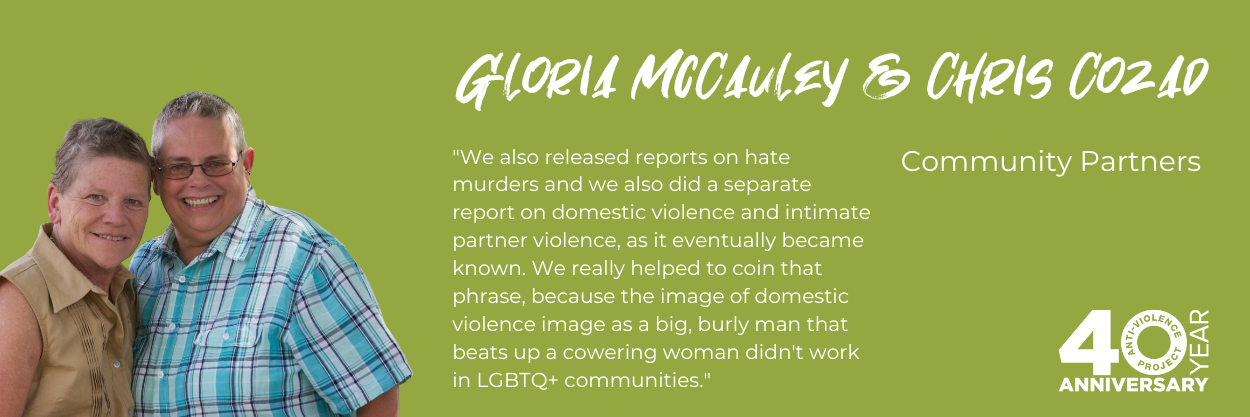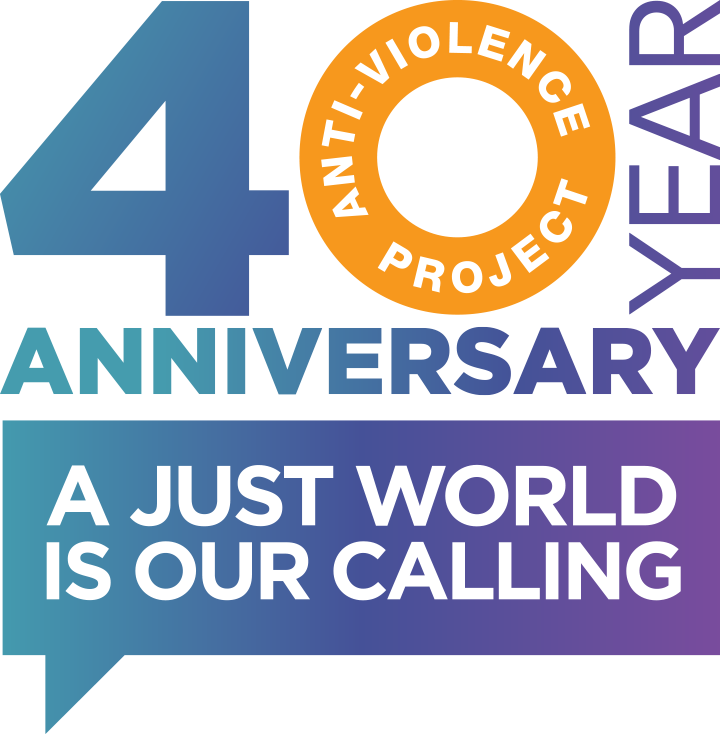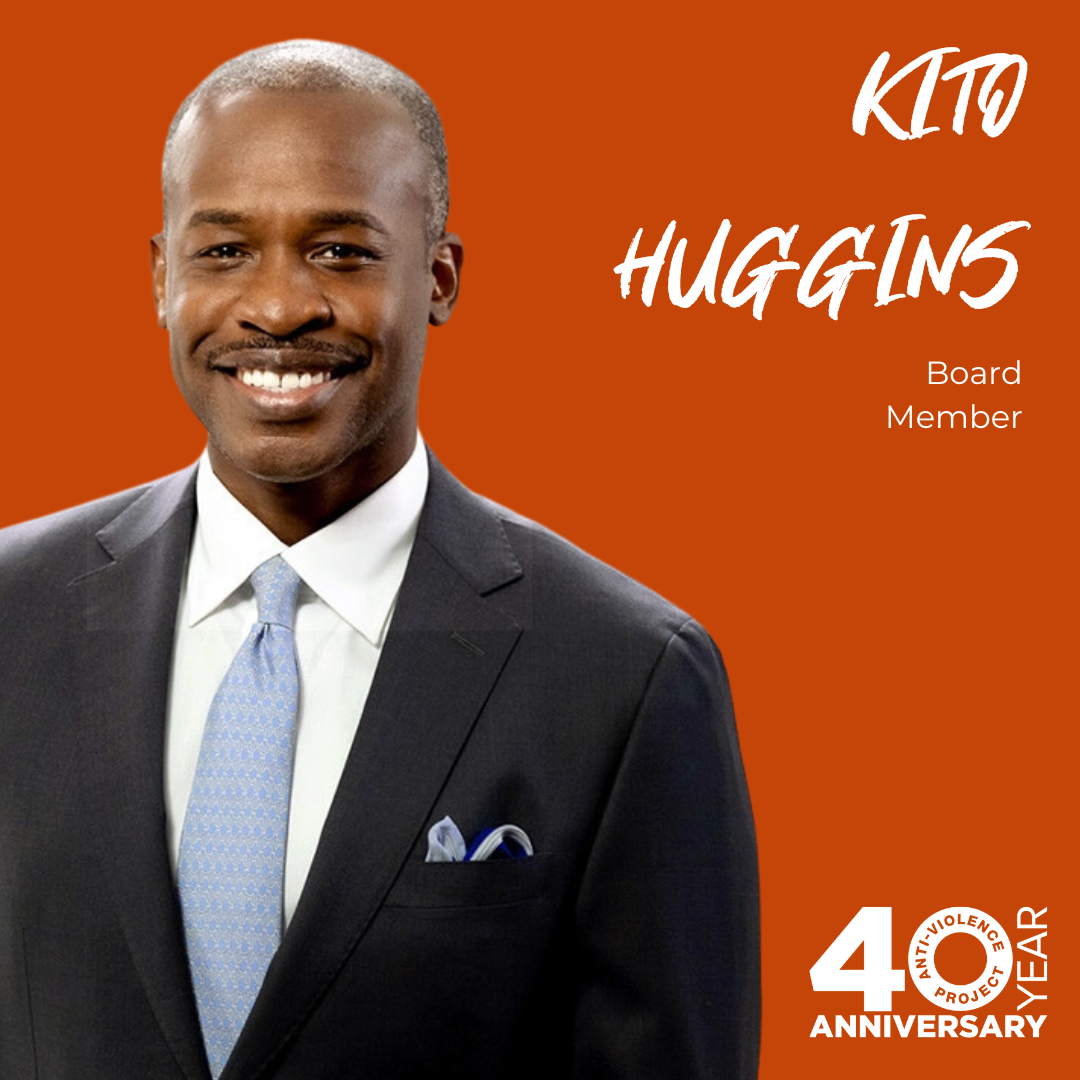
For years, Gloria McCauley and Chris Cozad ran the Buckeye Region Anti-Violence Project (BRAVO), creating a space for LGBTQ+ people in the Midwest. In an obituary for the late, beloved McCauley last year, the Buckeye Flame recalled that she “never said no to a queer kid in need of space, whether for a night, a month or longer.” While Cozad is no longer a part of BRAVO, her work and love for the LGBTQ+ community in Columbus, Ohio continue.
Chris talked to AVP about Gloria’s legacy, BRAVO, NCAVP, and sustainable coalition building.
How did you get involved with anti-violence work and AVP?
Gloria and I started doing anti-violence work more years ago than I can count, in those early days, the Task Force was coordinating some anti-violence work. There was a fellow there named Kevin Berrill who led that work in the beginning. Through that, we met a number of folks around the country, not just at AVP, but at CUAV in San Francisco and the Triangle Foundation in Detroit, various other AVPs. We felt like we should come together and work together so we started talking about an organization/ coalition that we loosely called NCAVP, the National Coalition of Anti-Violence Programs, which of course was eventually rolled into being a part of AVP.
We were initially interested in documentation efforts, and for many years we worked on reports together and we would all submit our statistics. We worked to standardize the terminology and the ways that we were tracking and what the offenses were because every jurisdiction, whether local, state, or federal, had slightly different definitions. We tried to standardize definitions so that we were comparing apples to apples rather than just random numbers. Gloria and I first got involved at that very early level and we were really in from the very beginning of the organized national movement around anti-violence work.
The first high-profile case we were involved with was when Rebecca White and Claudia Brenner were attacked on the Appalachian Trail and Rebecca died. Claudia, as a survivor, and was very much involved with what at the time was NGLTF, now the Task Force. We learned a lot about media management and messaging with that case that served us well later. Over the years we were involved in a number of really high-profile cases, most notably of course Matthew Shepherd, but there was also the Andrew Cunanan manhunt, the man who killed Gianni Versace. There was the Scott Amedure murder that was tied to the Jenny Jones TV show. There were many high-profile national cases that we were involved with. In terms of media management, we did a lot of work with GLAAD [on] messaging, how to get people to talk about it differently, centering the survivor or the victim rather than the killer.
Over the years, we were involved with NCAVP. It was way before Zoom, which would’ve made it a whole lot easier, but we had conference calls and we met at least once a year for our annual round table where we would get together and work with other anti-violence projects.
We started with the Hate and Bias Violence Report, which we did every year for many years. We also released reports on hate murders and we also did a separate report on domestic violence and intimate partner violence, as it eventually became known. We really helped to coin that phrase, because the image of domestic violence image as a big, burly man that beats up a cowering woman didn’t work in LGBTQ+ communities. We were dealing with these folks individually at our home projects, which was BRAVO, the Buckeye Region Anti-Violence Organization for Gloria and I, both as client services and helping those folks seek access to justice, whatever that looked like. Sometimes it was help working with police, sometimes it was help working with media, sometimes it was helping them find the right medical care or mental health care. It was about what they needed and what they wanted help with.
There was a community component to it, too, and educating our community and also the larger public about the issue and the things that were unique about hate violence. We worked in coalition with a lot of other LGBTQ organizations, but we also worked in coalition with other anti-violence groups. We worked with the Anti-Defamation League. We worked with the Southern Poverty Law Center. We worked with Southerners on New Ground. We did a lot of work around anti-racism, anti-hate, and anti-bias stuff that was more than just LGBT because we recognized the intersections even way back then.
What was that like on the day-to-day for you and Gloria in Ohio?
Well, Gloria worked full-time. She was the Executive Director and I was on the board and a good chunk of the early days, a board president, but we’re talking about Gloria, and so she had all of the pieces. She eventually had some other staff, but she initially did all of the victim and survivor services. She did all the law enforcement training. She did handle all the media stuff and wrote the grants and was kind of a jack of all trades if you will.
As we got bigger and got more grant funding, we were able to add more staff. Then some of that could be broken off into their specific areas. But in the early days, it was all Gloria all the time.
Her background was in violence against women. She was very involved in rape education and prevention. She coordinated Take Back The Night for many years before she got into LGBT work. So she had a long history of working around anti-violence issues more generically.
What drew you to work with AVP?
I think there’s a couple of ways to answer that. I mean in one way, it was about, as I mentioned earlier, sort of standardizing the work and creating the lexicon and doing some of those things, it’s like we don’t have to reinvent the wheel from Columbus to Denver to Detroit to New York. We could share resources. And so there was that sort of networking, sharing of resources.
It was also just a really special group of people. Lifelong friendships grew out of that and it was the connections as well. There is secondary traumatization that goes on when you work with people that are just, in some cases, experiencing horrible victimization or worse, murdered or exploited in any number of ways. So that secondary trauma is very real. There was a lot of informal support for one another. Knowing that you had someone that you could call and say, “Oh my gosh, I got this call. It’s just this terrible case or this terrible situation.” So we were each other’s brain trust and we were really able to share information, share support, say, “Hey, I know somebody. Here’s a phone number.”
Were there any particular cases or legal victories that you worked on with AVP that stand out to you?
We did a lot of work with Judy and Dennis Shepherd around Matthew’s murder. That was clearly probably the highest-profile case, but we did a lot of work around things like dispelling the gay panic defense. “Well, I was afraid they were going to hit on me,” that kind of thing.
We also worked a lot on public sex environments and men having sex with men. Nowadays they tend to hook up on things like Grindr, but in the old days, it was in the parks. There was a lot of complexity to that issue because it’s not simple–I mean the city police departments viewed it as, “Oh, it’s a crime. We have to arrest these people.” It was much more complex than that, ruining people’s lives. We were in the eye of the HIV and AIDS epidemic, there were all kinds of factors.
How do you work with law enforcement when what they want to do is go in and bust you? And trying to change the perspective with law enforcement in particular, that LGBT folks were either victims or perpetrators, those were the only two ways that we were seen. We weren’t looked at as citizens or partners or residents or any of that. We worked a lot on that kind of stuff.
We also worked very closely in the early days with the Justice Department and the Civil Rights Division of the Justice Department, which was interesting because there was just a seminar webinar thing just the other day that I attended that the Justice Department did. And I’m like, “Man, we were doing this work when Janet Reno was the Attorney General and Bill Clinton was the President.” We would go to Washington and meet with the Justice Department.
This is kind of a funny anecdote, but we had a meeting with Eric Holder when he was the Head of the Civil Rights Division back in the 90s, and there were probably 15 of us from various anti-violence programs around the country and we’re all going around and introducing ourselves. And Gloria introduced herself as being the Executive Director of the Buckeye Region Anti-Violence Project in Ohio. And Eric Holder said to her, “I’ve always wondered, what is a Buckeye exactly?” And without even thinking for a moment, she said, “It’s a poison nut.” And we all cracked up, including Eric Holder. It was kind of a funny moment, but in reality, it’s the state tree, it’s the mascot of the Ohio State University. It’s a lot of things, but her answer was a poison nut.
We changed the conversation in lots of ways, at both the federal and at local levels.
What do you think does build sustainability in anti-violence work?
I think there’s a couple of pieces. Clearly, there’s financial sustainability. There’s got to be grant funding, and there is some grant funding, but there needs to be more money. The work needs to not happen “over here.” It can’t just be its own little thing, it has to be incorporated into a variety of other areas of work, whether that’s anti-oppression, because oppression is on the violence continuum and whether it is anti-oppression work, coalition work with other like-minded groups, or whether it’s working legislatively to pass inclusive legislation of any sort, hate crimes legislation or non-discrimination legislation. We also have to be good allies, and I think that’s part of what we learned too, is that you can’t just work for your cause, you have to help with other causes and they have to help you and we have to recognize that it’s a larger societal and systemic problem than just, “We’ll go beat up the queers.”
There’s also that coalition and allyship work, there’s the financial piece. There’s also the trauma recovery piece and supporting each other because burnout’s a huge part of what happens, and it has happened and continues to happen around violence against women and all of those kinds of anti-violence work. You can only do that work so long without beginning to question your own sanity. That sort of trauma recovery piece, I think, is part of the piece that was missing, particularly in the early days. And that’s where NCAVP helped with that, was just that informal network of, “My gosh, I can call somebody and say, hey, this terrible thing just happened.”
Are there any other memories that you want to share about Gloria?
Her passion around anti-violence and the justice gene and having to do something when you see that kind of stuff was a huge piece of her heart. She was just tireless. She would never say no. And that is currently my problem as well. Something comes up and someone calls and says, “Oh, Gloria or Chris will help with that,” and she always would because it was that important to her. It was really the fire in her belly. Anti-Violence work was the fire in her belly.




